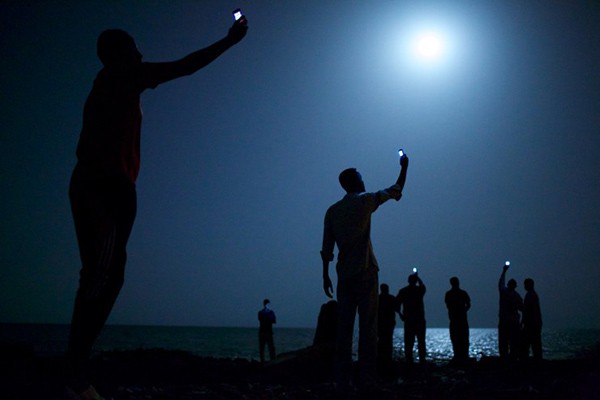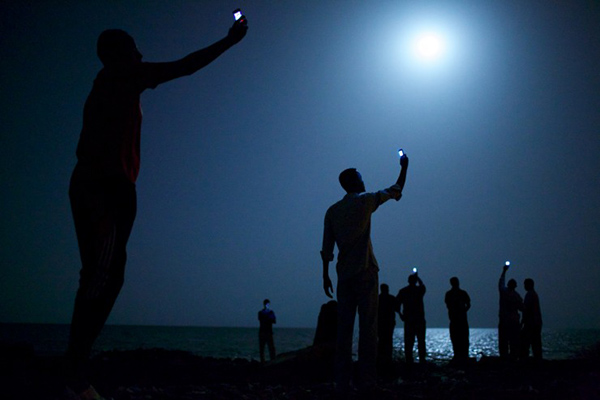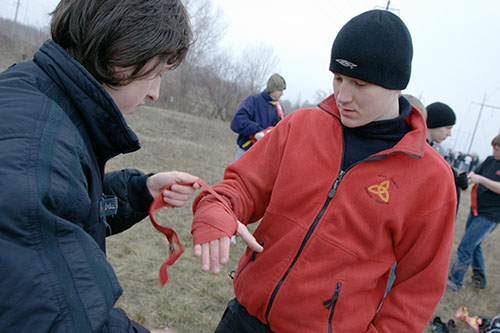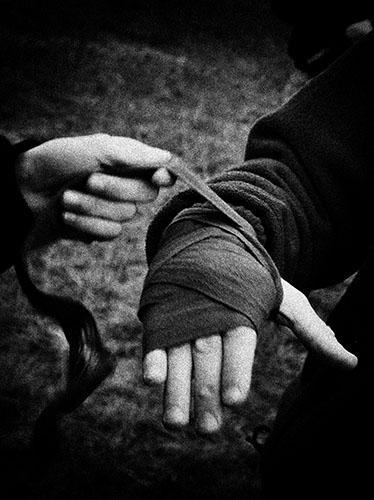Share
This Contest Winner Looks Like a Movie Poster (And That’s Good)
John Stanmeyer of VII won the World Press Photo of the Year on Thursday with this magnificent image of migrants in Djibouti trying to get a cheaper...

John Stanmeyer of VII won the World Press Photo of the Year on Thursday with this magnificent image of migrants in Djibouti trying to get a cheaper cell phone signal from neighboring Somalia.
It looks like a movie poster, but not for the reasons that I complained about last year. In a departure from the typical, hard hitting spot news image that has typified almost every winner since the contest inception, Stanmeyer’s image is a quiet image that (literally) illuminates so many issues of modern life: immigration, communication, technology and more. Jury member and former WPP winner David Guttenfelder commented in the LENS blog, “It might provoke debate, but will signal to photographers that they can cover events with a different visual language and they will be taken seriously.” In a video produced by WPP on the winner, Gary Knight extolled that “This image is so hopeful.” In many ways, the image solves the oft-heard complaint that photojournalism is depressing and only highlights the plight of the suffering. I applaud the selection.
Amid all the celebration and discussion of John Stanmeyer’s non-traditional winning image, was the disclosure by jury Chairman, Gary Knight, that 8% of the final round images were disqualified for manipulation. Speaking to James Estrin on The New York Times LENS blog, Knight lamented, “As a photographer, I reacted with real horror and considerable pain because some of the changes were materially trivial but they were ethically significant. In every single case it was a meaningless and stupid process. None of the photographers improved their work and if they hadn’t done it they may well have been up for consideration.”
Since 2010, WPP has required photographers to submit RAW files, and in that year, Stepan Rudik’s 3rd place Sports Feature work was disqualified after judges determined that he had manipulated a photo. In Rudik’s case, he cropped the following image from a horizontal to a vertical, and then converted it into black and white. Here is the original:
And the submitted image:
But the image in 2010 wasn’t disqualified because of the crop and black and white conversion, it was because he took a white shoe from the background near the index finger and effectively made it disappear by heavy burning. To the judges, the violation was clear: a lighter object in the scene was obliterated in a way that altered the veracity of the photo.
This year, 10 entries in the final round were disqualified by the jury after consultation with an outside forensic effort would looked at cloning and “extreme toning,” and the affected photographers were being notified of their disqualification. That is 10 entries from a final round of about 125. It’s scary to think, therefore, how many of the original 5,754 photographers from the initial round also would have failed the examination. And even scarier to think how this extrapolates to every photo that runs across the wire on a daily basis.
I applaud WPP for hiring an independent consultant to analyze the files. In a technological world, we constantly struggle to reconcile rapid advances with ethical and moral dilemmas. It has been well over a decade since news organizations started to adopt DSLRs en masse, and WPP is the first mainstream organization that incurred the expense and time to address the pervasive issue of digital manipulation. In doing so, it has bolstered its credibility and positioned itself as a forward looking organization that doesn’t shy away from the challenges of photo manipulation.
But WPP could go further:
- Release specifics on the methodology used by the forensic expert. Using an independent expert is a major step forward, but the process is still opaque. If, for example, the expert was using a simple software tool to make an initial determination, that same tool could be made available to photographers while they are assembling their entries. The industry’s goal shouldn’t be to apply a punitive measure after the fact, but rather, to help educate photographers so that the best work can rise to the top and be seen by all.
- Show visual examples of manipulation. While privacy issues would likely prevent this year’s disqualified entries from being displayed, there is clearly a lack of “real life” examples that the industry can use to foment a discussion. Perhaps we will see some of the ten disqualified entrants rise up to the challenge and show us their work. In their absence, it would be easy to take “well known” images and apply manipulation to show acceptable and non-acceptable actions.
- Continue to refine the definition of “acceptable” cropping and toning. We often see terms like “traditionally applied darkroom techniques” or “industry accepted cropping and toning,” but the fact of the matter is that this language is insufficient. And as we saw from Paul Hansen’s winning image last year, there is a wide range of opinion of acceptability between US and European counterparts. At the end of the day, manipulation is the act of taking a pixel and changing its originally recorded value. We should theoretically be able to get to a point where we can mathematically define what is acceptable, so that we are not reliant on the imprecision of language.
The challenges of digital manipulation won’t ever be fully eradicated, but major contests like WPP can help define the tone for this generation of photographer by continuing to lead with clear and decisive rules and enforcement.





